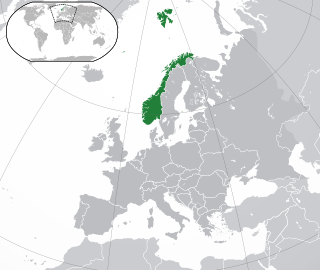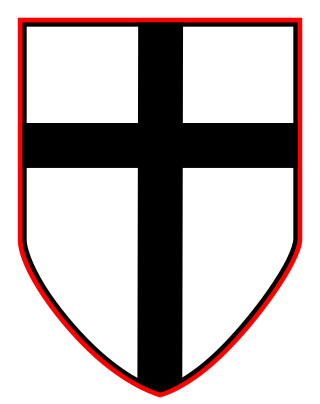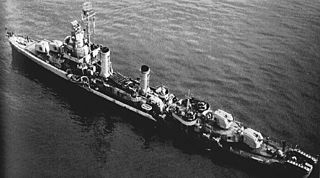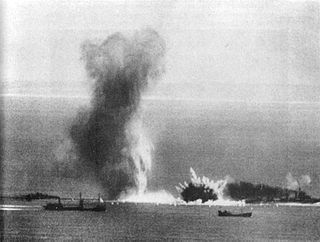
The Junkers Ju 87, popularly known as the "Stuka", is a German dive bomber and ground-attack aircraft. Designed by Hermann Pohlmann, it first flew in 1935. The Ju 87 made its combat debut in 1937 with the Luftwaffe's Condor Legion during the Spanish Civil War of 1936–1939 and served the Axis in World War II from beginning to end (1939–1945).

HMS Illustrious was the lead ship of her class of aircraft carriers built for the Royal Navy before World War II. Her first assignment after completion and working up was with the Mediterranean Fleet, in which her aircraft's most notable achievement was sinking one Italian battleship and badly damaging two others during the Battle of Taranto in late 1940. Two months later the carrier was crippled by German dive bombers and was repaired in the United States. After sustaining damage on the voyage home in late 1941 by a collision with her sister ship Formidable, Illustrious was sent to the Indian Ocean in early 1942 to support the invasion of Vichy French Madagascar. After returning home in early 1943, the ship was given a lengthy refit and briefly assigned to the Home Fleet. She was transferred to Force H for the Battle of Salerno in mid-1943 and then rejoined the Eastern Fleet in the Indian Ocean at the beginning of 1944. Her aircraft attacked several targets in the Japanese-occupied Dutch East Indies over the following year before Illustrious was transferred to the newly formed British Pacific Fleet (BPF). The carrier participated in the early stages of the Battle of Okinawa until mechanical defects arising from accumulated battle damage became so severe she was ordered home early for repairs in May 1945.

Operation Pedestal, known in Malta as Il-Konvoj ta' Santa Marija, was a British operation to carry supplies to the island of Malta in August 1942, during the Second World War.

HMS Afridi was one of 16 Tribal-class destroyers built for the Royal Navy shortly before the beginning of Second World War in 1939. Completed in 1938 the ship was initially assigned to the Mediterranean Fleet where she served as a flotilla leader. Afridi was briefly involved enforcing the arms blockade on the combatants in the Spanish Civil War. The ship returned home shortly after the start of the Second World War and was assigned convoy escort duties. She played an active role in the Norwegian Campaign of April–May 1940, escorting convoys to and from Norway. Afridi was sunk by German dive bombers on 3 May as she was escorting the evacuation convoy after the failure of the Namsos Campaign.

HMS Eagle was an early aircraft carrier of the Royal Navy. Ordered by Chile during the South American dreadnought race as the Almirante Latorre-class battleship Almirante Cochrane, she was laid down before World War I. In early 1918 she was purchased by Britain for conversion to an aircraft carrier; this work was finished in 1924. Her completion was delayed by labour troubles and the possibility that she might be repurchased by Chile for reconversion into a battleship, as well as the need for comparative trials to determine the optimum layout for aircraft carriers. The ship was initially assigned to the Mediterranean Fleet and then later to the China Station, spending very little time in home waters other than for periodic refits.

Convoy PQ 16 was an Arctic convoy of British, United States and Allied ships from Iceland to Murmansk and Archangelsk in the Soviet Union during the Second World War. The convoy was the largest yet and was provided with a considerable number of escorts and submarines. QP 12, a return convoy, sailed on the same day

Operation Vigorous was a British operation during the Second World War, to escort supply convoy MW11 from the eastern Mediterranean to Malta, which took place from 11 to 16 June 1942. Vigorous was part of Operation Julius, a simultaneous operation with Operation Harpoon from Gibraltar and supporting operations. Sub-convoy MW11c sailed from Port Said (Egypt) on 11 June, to tempt the Italian battlefleet to sail early, use up fuel and be exposed to submarine and air attack. MW11a and MW11b sailed next day from Haifa, Port Said and Alexandria; one ship was sent back because of defects. Italian and German (Axis) aircraft attacked MW11c on 12 June and a damaged ship was diverted to Tobruk, just east of Gazala. The merchant ships and escorts rendezvoused on 13 June. The British plans were revealed unwittingly to the Axis by the US Military Attaché in Egypt, Colonel Bonner Fellers, who reported to Washington, D.C. in "Black"-coded wireless messages; it was later discovered that the Black Code had been broken by the Servizio Informazioni Militare.

The Battle of the Tarigo Convoy was a naval battle of the Second World War, part of the Battle of the Mediterranean. It was fought on 16 April 1941, between four Royal Navy destroyers and three Italian destroyers of the Regia Marina which were escorting a convoy near the Kerkennah Islands off Sfax, on the Tunisian coast.

Convoy PQ 18 was an Arctic convoy of forty Allied freighters from Scotland and Iceland to Arkhangelsk in the Soviet Union in the war against Nazi Germany. The convoy departed Loch Ewe, Scotland on 2 September 1942, rendezvoused with more ships and escorts at Iceland and arrived at Arkhangelsk on 21 September. An exceptionally large number of escorts was provided by the Royal Navy in Operation EV, including the first escort carrier to accompany an Arctic convoy. Detailed information on German intentions was provided by the code breakers at Bletchley Park and elsewhere, through Ultra signals decrypts and eavesdropping on Luftwaffe wireless communications.

HMS Petard was a P-class destroyer of the British Royal Navy that saw service during the Second World War. She was one of only three P-class ships, out of the original eight, to survive the war in a serviceable condition.

Sturzkampfgeschwader 2 Immelmann was a Luftwaffe dive bombing squadron wing of World War II. It was named after the World War I aviator Max Immelmann. It served until its dissolution in October 1943. The wing operated the Junkers Ju 87 Stuka exclusively.

HMS Havant was an H-class destroyer originally ordered by the Brazilian Navy with the name Javary in the late 1930s, but was bought by the Royal Navy after the beginning of World War II in September 1939. The ship was initially assigned to escort duties in the Western Approaches, but was transferred to the Home Fleet when the Norwegian Campaign began in April 1940. She was only peripherally involved in the campaign as she escorted ships carrying troops that occupied Iceland and the Faeroe Islands as well as convoys to Narvik. Havant was evacuating troops from Dunkirk when she was badly damaged by Junkers Ju 87 Stuka dive bombers on 1 June and had to be scuttled.

HMS Delight was a D-class destroyer built for the Royal Navy in the early 1930s. Delight was initially assigned to the Mediterranean Fleet before she was transferred to the China Station in early 1935. She was temporarily deployed in the Red Sea during late 1935 during the Abyssinia Crisis, before returning to her duty station where she remained until mid-1939. Delight was transferred back to the Mediterranean Fleet just before the Second World War began in September 1939. She served with the Home Fleet during the Norwegian Campaign. The ship was sunk by German dive-bombers on 29 July 1940 while attempting to transit the English Channel in daylight.
HMS Foylebank was a converted 5,500 ton merchant ship active during the Second World War. She was launched as the MV Foylebank by Bank Line in 1930 and requisitioned by the Royal Navy in September 1939. She was converted into an anti-aircraft ship, equipped with 0.5 inch (12.7 mm) machine guns, two quad 2-pounder pom-poms and four twin high angle 4-inch gun turrets. The Foylebank saw action in Portland Harbour next to the Isle of Portland in Dorset, England. She arrived in Portland on 9 June 1940 for a work-up to anti-aircraft duties commanded by Captain Henry P. Wilson.

Sturzkampfgeschwader 1 was a Luftwaffe dive bomber wing during World War II.

The action off Cape Bougaroun, or the Attack on Convoy KMF-25A was a Luftwaffe action against an Allied naval convoy off the coast of Algeria during World War II. The convoy of American, British, Greek and Dutch ships was attacked on 6 November 1943 by 25 German land-based aircraft. Six Allied vessels were sunk or damaged and six German aircraft were destroyed. German forces achieved a tactical victory, though the Allied warships involved received credit for defending their convoy and reacting to their losses quickly. The quick response led to the rescue of over 6,000 servicemen and civilians without further loss of life.

Francis Alonzo Dales was a cadet midshipman in the U.S. Merchant Marine Academy who served on the freighter SS Santa Elisa, and subsequently the tanker SS Ohio, during Operation Pedestal, a convoy to the besieged island of Malta in the Second World War. For his actions defending the convoy, considered one of the most important British strategic victories of the war, he was awarded the Merchant Marine Distinguished Service Medal.
British Corporal was a 6,972 GRT tanker that was built in 1922 by Palmers Shipbuilding and Iron Company, Jarrow, Northumberland, United Kingdom. She was built for the British Tanker Company.

The Kanalkampf was the German term for air operations by the Luftwaffe against the Royal Air Force (RAF) over the English Channel in July 1940, beginning the Battle of Britain during the Second World War. By 25 June, the Allies had been defeated in Western Europe and Scandinavia. Britain had rejected peace overtures and on 16 July, Adolf Hitler issued Directive 16 to the Wehrmacht, ordering preparations for an invasion of Britain, under the codename Unternehmen Seelöwe.
The Slamat disaster is a succession of three related shipwrecks during the Battle of Greece on 27 April 1941. The Dutch troopship Slamat and the Royal Navy destroyers HMS Diamond and HMS Wryneck sank as a result of air attacks by Luftwaffe Junkers Ju 87 dive bombers. The three ships sank off the east coast of the Peloponnese during Operation Demon, which was the evacuation of British, Australian and New Zealand troops from Greece after their defeat by invading German and Italian forces.




















